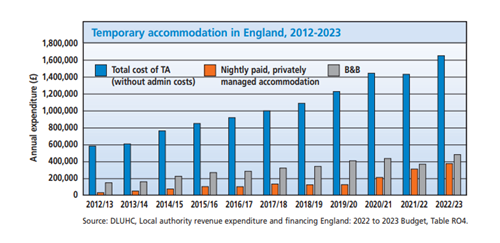28 Oct 2024
Tackling rising use of temporary accommodation must be a priority

Francesca Albanese, executive director of policy & social change at Crisis says that tackling the rising use of temporary accommodation must be a priority for any strategy to end homelessness.
A direct consequence of the housing crisis are the record levels of households trapped in temporary accommodation (TA) in England. With nowhere else for people to go, the numbers have more than doubled over ten years and over 151,000 children are now living in some form of temporary accommodation. In London, 63 per cent of households with children have been in TA for two years or longer.
It is not only ruining lives but driving council finances to bankruptcy. There has been a sharp increase in expenditure – with costs jumping from £1.7 billion to £2.3 billion in the last year alone.
Whilst the overall costs are eye watering, there is a noticeable shift in the type of TA being relied on. There has been a disproportionate rise in nightly paid, privately managed accommodation increasing from six per cent of the total bill to 30 per cent over the last ten years. These are self-contained units which can include hotels and are rented on a short-term nightly basis. In the last four years spend on this type of TA has seen nearly a five fold increase from £128 million to £635 million across England. When added to B&B costs this represents over 60 per cent of TA spend in the last 12 months.

A recent London Assembly inquiry into London’s TA emergency highlighted that some TA providers are converting from long term lets to a nightly let basis because it is deemed more profitable. There is a huge risk that rising demand will further skew how accommodation is procured in the short term unless the whole TA model is looked at and the relationship it has to wider housing market dynamics.
As this year’s UK Housing Review Autumn briefing paper highlights, the government’s target to build 1.5 million homes is very welcome by all of us working in the housing and homelessness sector. But it isn’t without its obstacles. Investment in the social housing sector must be part of that solution. It is critical that a substantial proportion of these homes are delivered at social rent (at least 90,000 a year) with local housing targets based on levels of homelessness in each area.
Success of tackling all forms of homelessness (not only rough sleeping) sustainably over the long term has to stop things getting worse whilst simultaneously working on the long-term reform. A cross-government homelessness strategy with genuinely affordable housing and prevention across all public services at the centre is a large part of the solution. And one we are all set to get behind and want to succeed.
But with the immediate homelessness crisis only getting worse, we must also address the TA problem head on. This means investment in short term fixes like lifting the TA subsidy cap which has been frozen since 2011 and would significantly help councils facing funding shortfalls now. We can also shift funding right now through the Affordable Homes Programme to deliver more social homes.
There is so much potential to invest in solutions that both drive economic growth and stop more people experiencing the trauma of homelessness. Let’s make sure fiscal decisions in this week’s budget are bold enough to meet this ambition.
This blog is an edit of an article published in the 2024 UK Housing Review Autumn Briefing Paper, which is available to download for free by clicking the following link: www.cih.org/media/ox2gxc55/ukhr-autumn-briefing-2024.pdf


